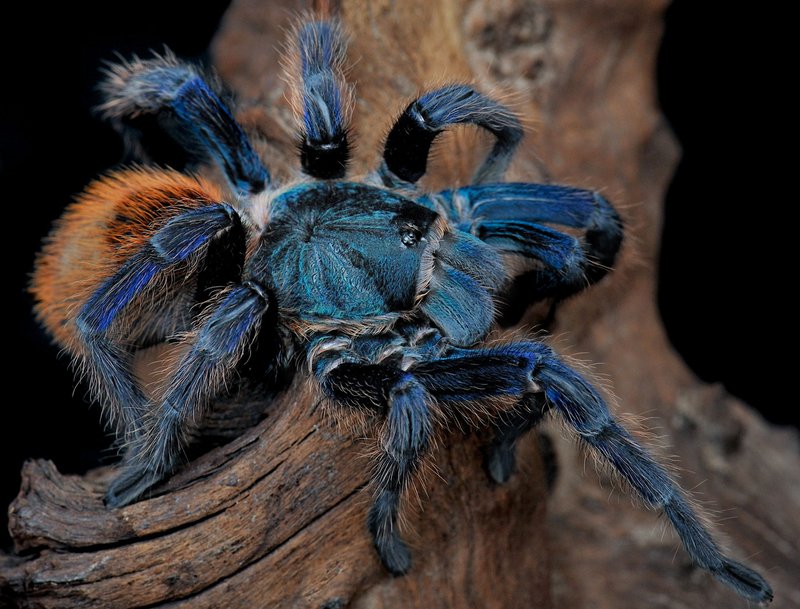
Imagine sitting in a cozy café, sipping your favorite drink, as we unravel the truth behind handling the Cobalt Blue Tarantula. It’s like debating whether to try the spiciest dish on the menu; you want to know what’s safe and worth it. So, let’s get into it!
What Makes the Cobalt Blue Tarantula Special?
The Cobalt Blue Tarantula, or *Haplopelma lividum*, is native to Southeast Asia, particularly found in places like Myanmar and Thailand. It’s famous for its gorgeous and vibrant blue exoskeleton, which can dazzle anyone who gazes at it. Beyond aesthetics, these tarantulas are known for their web-building skills. They craft silk tunnels in their burrows, giving them a unique aesthetic that some enthusiasts adore.
Now, here’s the thing: the Cobalt Blue is also known to be a bit skittish. They have a reputation for being defensive rather than aggressive, but their quick movements can surprise newcomers. If you think of it like a cat—quick and sometimes unpredictable—handling them might require a certain level of care and patience.
Is It Safe to Handle Cobalt Blue Tarantulas?
You might be wondering if it’s safe to handle these beautiful creatures. The short answer? It depends. While many keepers enjoy interacting with their tarantulas, the Cobalt Blue isn’t the most beginner-friendly option. They tend to be more defensive than other species, and their first instinct might be to run away or even bite if they feel threatened.
If you’re considering handling one, think of it as walking a tightrope. It can be done, but you have to be careful. Their venom isn’t lethal to humans, but bites can cause pain and some unpleasant symptoms like swelling or an allergic reaction. So, if you decide to go for it, make sure you’re cautious and prepared!
Preparing for Safe Handling
Alright, you’ve done your research, and you’re still interested in handling your Cobalt Blue Tarantula. Let’s talk about how to do it safely! Here’s a simple step-by-step guide to ensure you minimize risks while interacting with your new pet:
- Understand the Temperament: Before you even think about touching your tarantula, observe its behavior. If it seems calm and is not hiding, it might be a good time.
- Pick the Right Time: Handling is best done during their active hours, which is usually in the evening. This way, they’re alert and ready to interact.
- Prepare Your Space: Make sure you have a quiet environment. A loud or busy area can stress your tarantula, leading to defensive behavior.
- Use Proper Techniques: When you do decide to handle your tarantula, gently coax it onto your hand rather than grabbing it. This way, it feels less threatened.
Following these steps can help create a safer experience for both you and your pet.
What to Expect When Handling
So, you’re ready to handle your Cobalt Blue Tarantula. What can you expect? This spider is known for its speed and agility. When you first bring it out, it may seem a bit disoriented or anxious. Imagine how you’d feel if you were suddenly lifted from your cozy spot!
You might notice it moving quickly across your hand or looking for a safe place to hide. This is normal behavior. Here’s what you should keep in mind:
– Stay Calm: If you panic, your tarantula will sense it and may react unpredictably. Breathe and move slowly.
– Keep Your Hand Low: Holding your hand low to a surface can help if it decides to jump or fall. You want to give it a safe landing.
– Limit Handling Time: Tarantulas don’t thrive on social interaction like dogs or cats, so keep handling sessions short—about 5 to 10 minutes is often sufficient.
Signs of Stress in Your Tarantula
Just as humans can show signs of stress, so can your Cobalt Blue Tarantula. It’s essential to recognize these signs so you can respond appropriately and reduce handling if needed. Here are some common indicators:
– Speeding up Movement: If your spider starts moving faster than usual, it might be a sign that it’s feeling threatened.
– Defensive Posture: If it rears up or displays its fangs, that’s your cue to back off. It’s feeling cornered and needs space.
– Hiding: If your tarantula suddenly seeks cover, it’s best to let it go back to its burrow. Like we all need our comfort zones, so do they!
Understanding these cues can help ensure a better experience for both of you.
Alternative Ways to Interact
If handling a Cobalt Blue Tarantula doesn’t seem appealing to you, that’s perfectly okay! There are plenty of other ways to bond with your pet without the physical contact. Here are some alternatives:
- Observation: Spend time watching your tarantula as it moves around its enclosure. You’ll learn a lot about its behavior and personality this way.
- Feeding Time: Watching its feeding can be fascinating. You can even try to create a little routine around it. Just don’t overdo the treats!
- Enrichment Activities: Set up its habitat with hiding spots and tunnels. This gives your tarantula mental stimulation and keeps it engaged.
These methods can deepen your connection while keeping both you and your spider safe.
In conclusion, handling the Cobalt Blue Tarantula can be safe if you approach it correctly. Remember, these spiders are stunningly beautiful but come with their own set of challenges. If you’re new to pet ownership or arachnids, consider sticking to species that are known for their easy-going nature.
Ultimately, your experience with your Cobalt Blue Tarantula might vary. The key is to respect its behavior and boundaries. If you choose to handle it, do so with care and patience, ensuring both you and your pet have a positive experience. Whether you decide to hold it or simply admire it from a distance, you’ll still get to enjoy the wonders of this exotic creature.

